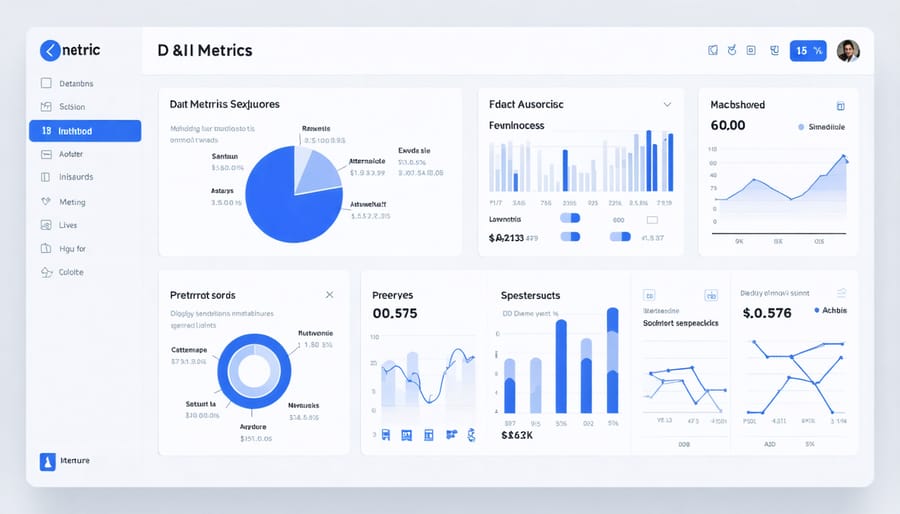Transform organizational culture by implementing diversity and inclusion core values that drive measurable business outcomes and strengthen corporate social responsibility. Leading Canadian companies demonstrate these values through specific, actionable frameworks that consistently deliver results. From TD Bank’s inclusive leadership initiatives to Shopify’s equity-focused hiring practices, successful organizations embed diversity principles into every business decision.
Critical success factors include establishing clear metrics for diversity representation, creating inclusive policies that reflect Canada’s multicultural landscape, and developing accountability systems that ensure sustained progress. Research by Deloitte Canada shows organizations with strong diversity and inclusion core values achieve 35% better financial returns and demonstrate 70% higher employee engagement rates.
Forward-thinking businesses recognize that effective diversity and inclusion values extend beyond basic compliance—they fundamentally reshape workplace dynamics, drive innovation, and create competitive advantages in Canada’s evolving marketplace. This strategic approach requires leadership commitment, structured implementation processes, and regular assessment of outcomes against established benchmarks.
Building Authentic Diversity and Inclusion Values

Defining Your Organization’s D&I Mission
Crafting an effective diversity and inclusion mission statement requires careful consideration of your organization’s values, goals, and commitment to fostering an inclusive workplace. Start by engaging key stakeholders, including employees from diverse backgrounds, to ensure authentic representation of different perspectives.
Your D&I mission should be specific, measurable, and aligned with your broader organizational objectives. Rather than using generic statements, focus on actionable commitments. For example, “We actively seek diverse talent and create inclusive spaces where all team members can thrive” is more impactful than “We value diversity.”
According to Lisa Mattam, founder of Toronto-based Sahajan and diversity advocate, “An effective D&I mission statement should reflect both your current reality and your aspirations. It needs to be something your organization can genuinely work towards.”
Consider these key elements when developing your mission:
– Clear connection to business goals
– Specific, measurable objectives
– Accountability measures
– Implementation timeline
– Regular review and updates
Remember to make your mission statement visible and integrate it into all aspects of your organization’s operations, from recruitment to daily decision-making processes. This ensures your commitment to diversity and inclusion remains active and evolving rather than simply aspirational.
Aligning D&I Values with Business Strategy
Successful integration of diversity and inclusion values into business strategy requires a holistic approach that aligns with your organization’s corporate governance framework. Canadian companies like TD Bank and Shopify demonstrate how embedding D&I objectives into core business metrics drives both social impact and financial performance.
Start by incorporating D&I goals into your strategic planning process. This means setting measurable targets for diverse representation, inclusive practices, and equitable outcomes across all business units. Connect these objectives directly to revenue growth, innovation metrics, and talent retention strategies.
Create accountability mechanisms by tying leadership performance evaluations and compensation to D&I outcomes. Companies like CIBC have successfully implemented scorecards that track progress on diversity initiatives alongside traditional business metrics.
Ensure D&I initiatives support broader business goals such as market expansion, product innovation, and customer satisfaction. For example, diverse teams better understand varied customer needs, leading to improved product development and service delivery. Regular assessment of these alignments helps maintain momentum and demonstrates the tangible business value of your D&I commitment.
Exemplary D&I Core Values in Action
Inclusive Leadership Practices
Effective inclusive leadership practices drive organizational success by fostering a culture where diverse perspectives are valued and celebrated. Leading Canadian companies demonstrate this through various initiatives that reflect their commitment to diversity and inclusion.
For example, TD Bank implements reverse mentoring programs where senior executives are paired with employees from underrepresented groups, facilitating two-way learning and breaking down hierarchical barriers. RBC’s leadership actively participates in employee resource groups (ERGs) and ensures diverse representation in succession planning.
Successful inclusive leaders consistently demonstrate key behaviours:
– Actively seeking diverse perspectives in decision-making processes
– Creating psychological safety for team members to express concerns
– Establishing clear accountability metrics for diversity goals
– Modeling inclusive language and behaviour
– Supporting flexible work arrangements that accommodate different needs
– Investing in diversity training and development programs
TELUS exemplifies inclusive leadership through its commitment to achieving gender parity in senior management positions and maintaining diverse interview panels for all leadership roles. Shopify promotes inclusion by ensuring leadership development programs specifically target underrepresented groups.
To measure success, progressive organizations track metrics like diversity in leadership positions, employee engagement scores across different demographics, and retention rates of diverse talent. They also regularly collect feedback through anonymous surveys and town halls to identify areas for improvement and adjust their approach accordingly.

Workplace Culture and Belonging
Creating an inclusive workplace culture starts with establishing core values that celebrate diversity and promote belonging. Successful Canadian organizations recognize that building thriving teams requires fostering an environment where every employee feels valued and heard.
Essential workplace culture values include respect for different perspectives, open communication, and psychological safety. Leading companies like Shopify and TD Bank demonstrate this through their mentorship programs, employee resource groups, and inclusive leadership training initiatives.
Consider implementing these proven workplace values:
– Active listening and validation of diverse experiences
– Celebration of cultural festivities and observances
– Flexible work arrangements that accommodate different needs
– Regular feedback sessions that welcome diverse viewpoints
– Zero-tolerance policies for discrimination and harassment
Industry leaders emphasize the importance of making these values visible in daily operations. This includes using inclusive language in communications, ensuring diverse representation in decision-making processes, and creating opportunities for cross-cultural collaboration.
According to the Canadian Centre for Diversity and Inclusion, organizations that successfully embed these values report higher employee engagement, increased innovation, and stronger team cohesion. By prioritizing workplace culture and belonging, companies create sustainable, resilient environments where all team members can contribute their best work.
Innovation Through Diversity
Innovation thrives when diverse perspectives converge to solve complex business challenges. Canadian companies that embrace diversity consistently report higher levels of creativity, problem-solving capabilities, and market understanding. A recent study by Innovation, Science and Economic Development Canada reveals that organizations with diverse leadership teams are 33% more likely to generate above-average profits through innovation.
Take Toronto-based tech firm Shopify, for example. By cultivating a workforce that represents various cultural backgrounds, experiences, and thinking styles, they’ve successfully expanded their e-commerce solutions to serve merchants across 175 countries. Their diverse team brings unique insights into different market needs and consumer behaviors, driving product innovation and global growth.
Similarly, Montreal’s Element AI demonstrates how cognitive diversity—different approaches to problem-solving and decision-making—leads to breakthrough developments in artificial intelligence solutions. Their cross-functional teams, comprising individuals from various educational and professional backgrounds, consistently deliver innovative solutions for complex industry challenges.
To foster innovation through diversity, successful Canadian organizations implement several key strategies:
– Creating inclusive brainstorming environments where all voices are heard
– Establishing diverse project teams to tackle complex challenges
– Encouraging cross-cultural collaboration and knowledge sharing
– Supporting employee resource groups that drive innovation initiatives
– Implementing mentorship programs that connect diverse talents across organizational levels
When organizations actively cultivate diverse perspectives, they unlock new opportunities for innovation, market expansion, and sustainable growth.
Measuring D&I Value Implementation

Key Performance Indicators
To effectively measure diversity and inclusion initiatives, organizations should track specific metrics that reflect progress and identify areas for improvement. Employee demographic data is a crucial baseline metric, examining representation across different organizational levels, departments, and roles. Track recruitment statistics, including the diversity of candidate pools, interview panels, and successful hires.
Employee engagement surveys provide valuable insights into inclusion effectiveness. Monitor participation rates in diversity programs, mentorship initiatives, and employee resource groups. Measure retention rates and promotion patterns across different demographic groups to identify potential barriers or biases in career advancement.
Leading Canadian companies like TD Bank and CIBC regularly assess pay equity metrics to ensure fair compensation across all employee groups. Track inclusion-related training completion rates and effectiveness through participant feedback and behavioral changes.
Additional meaningful metrics include supplier diversity percentages, customer satisfaction scores across diverse demographic groups, and the success rates of diversity-focused initiatives. Consider measuring the percentage of diverse representation in leadership development programs and succession planning.
Regular pulse surveys can gauge employee sentiment regarding workplace inclusion, belonging, and psychological safety. Document the number and impact of diversity-focused partnerships and community engagement initiatives. These metrics should be reviewed quarterly and annually to maintain accountability and drive continuous improvement in your organization’s diversity and inclusion efforts.
Continuous Improvement Strategies
To maintain momentum in diversity and inclusion initiatives, organizations must embrace a culture of continuous improvement. Regular assessment of D&I metrics, employee feedback surveys, and program effectiveness helps identify areas for growth and refinement.
Canadian companies like TD Bank demonstrate excellence in this approach by conducting quarterly diversity scorecards and implementing responsive action plans. This data-driven strategy ensures accountability and measures progress against established benchmarks.
Key improvement strategies include:
– Annual diversity audits to evaluate representation across all organizational levels
– Regular unconscious bias training updates incorporating new research and best practices
– Mentorship program evaluations to assess impact and participation rates
– Employee resource group feedback sessions to gather insights and suggestions
– External benchmarking against industry leaders and competitors
Organizations should establish clear mechanisms for employees to provide ongoing feedback about D&I initiatives. This might include anonymous suggestion boxes, regular town halls, or dedicated communication channels.
Success stories from companies like Shopify show the value of adapting D&I strategies based on employee input. Their “belonging barometer” program enables real-time adjustments to inclusion practices based on team member experiences.
Remember that improvement is an iterative process. Start with small, measurable changes and build upon successful initiatives. Document lessons learned and share best practices across departments to create sustainable, organization-wide progress in diversity and inclusion efforts.
Supporting Resources and Programs
Canada offers numerous resources and support programs to help organizations implement and strengthen their diversity and inclusion initiatives. The Canadian government, through various departments and agencies, provides funding, training, and guidance for businesses committed to advancing D&I practices.
Employment and Social Development Canada (ESDC) manages the Workplace Opportunities Fund, which offers financial support to organizations developing innovative solutions for workplace inclusion. This program specifically targets initiatives supporting persons with disabilities, Indigenous peoples, and other underrepresented groups.
The Business Development Bank of Canada (BDC) provides specialized consulting services and resources focused on helping businesses build inclusive workplace cultures. Their expertise includes diversity assessments, strategic planning, and implementation support for organizations of all sizes.
The Canadian Centre for Diversity and Inclusion (CCDI) offers comprehensive toolkits, educational resources, and professional certification programs. Their Employer Partner Program connects organizations with best practices, research, and networking opportunities to enhance D&I strategies.
Provincial governments also maintain dedicated programs supporting workplace diversity. For example, Ontario’s Diversity Office provides free online training modules and consultation services, while British Columbia’s Immigrant Employment Council offers mentorship programs connecting skilled immigrants with industry professionals.
Industry-specific associations frequently partner with government agencies to deliver targeted D&I programs. The Technology Council of Canada, for instance, runs initiatives supporting women and underrepresented groups in tech careers through mentorship and skills development programs.
For small and medium-sized enterprises, the Canada Business Network provides free resources and guides on implementing D&I practices, including templates for policy development and measurement frameworks.
Organizations can also access support through chambers of commerce and business improvement associations, which regularly host workshops and networking events focused on diversity and inclusion best practices. These local resources often provide practical, community-specific guidance for implementing D&I initiatives effectively.
Implementing diversity and inclusion core values is not just a checkbox exercise – it’s a transformative journey that can revolutionize your organization’s culture and performance. As we’ve explored throughout this article, successful Canadian organizations have demonstrated that well-defined D&I values drive innovation, enhance employee engagement, and create sustainable competitive advantages.
Remember that effective D&I core values must be authentic, actionable, and woven into every aspect of your business operations. Start by assessing your current organizational culture and identifying areas for improvement. Develop clear, measurable goals that align with your D&I values, and ensure leadership demonstrates unwavering commitment to these principles.
Take inspiration from Canadian success stories like TD Bank’s inclusive leadership programs and Shopify’s diversity initiatives, but develop approaches that authentically reflect your organization’s unique culture and challenges. Engage your employees in the process, seeking their input and feedback to create truly inclusive values that resonate across all levels.
The time to act is now. Begin by implementing small, meaningful changes that can scale over time. Monitor your progress, celebrate successes, and adjust strategies as needed. Remember that creating an inclusive workplace is an ongoing journey that requires patience, dedication, and continuous learning.
Your commitment to diversity and inclusion today will shape the future of your organization and contribute to a more equitable Canadian business landscape tomorrow.
